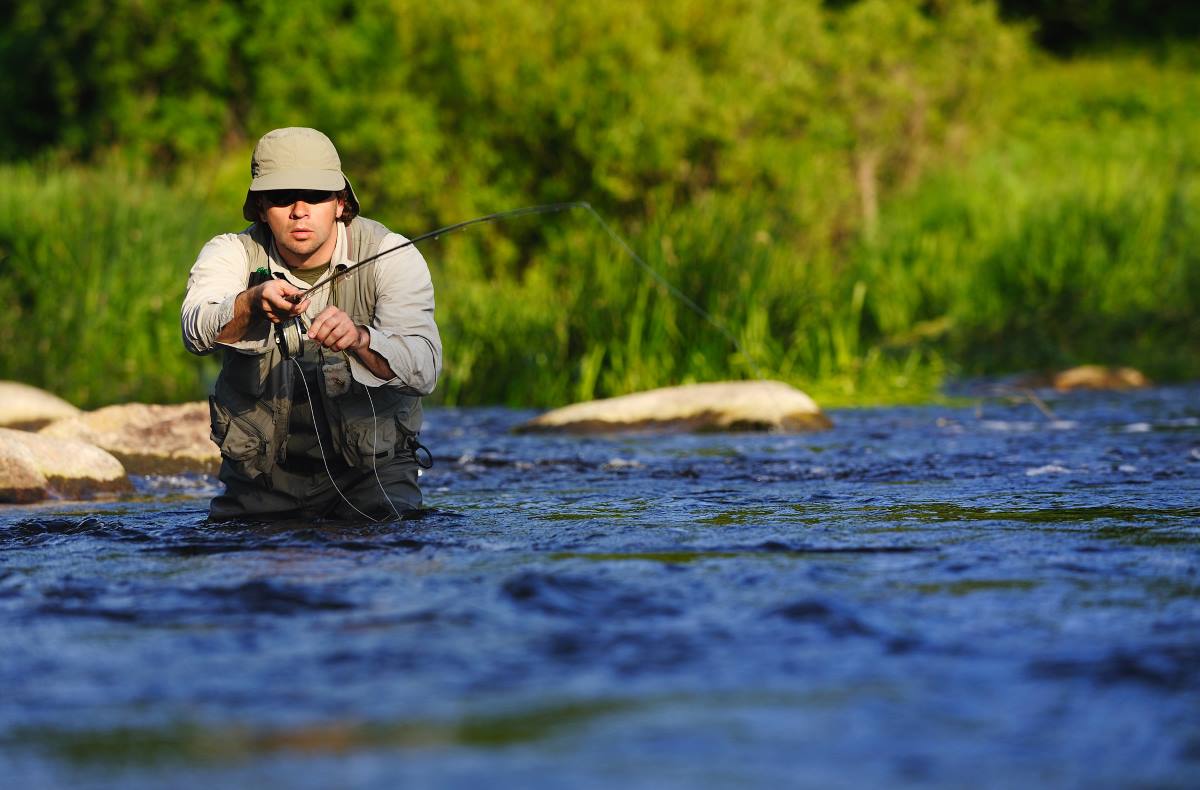5 Easy Mistakes to Make Fly Fishing for Trout in the Fall

5 Easy Mistakes to Make Fly Fishing for Trout in the Fall
Not only is fall one of the best times to fly fish for trout in Iowa, it’s also my favorite! The sweltering heat of summer begins to lose its grip, making the fishing much more comfortable and also making catch-and-release a much less lethal proposition for the trout. The places in Iowa where trout live also offer some of the most breathtaking colors as the leaves begin to change.
Fall also trips a switch in the metabolism of the trout. Winter is coming, and bug activity is beginning to slow significantly. The trout know that NOW is the time to consume as many calories as they can while aquatic bugs and other forage are plentiful in the stream before the lean times of winter settle in. This means the trout are ravenous and BIG trout are feeding more aggressively than they have at any other time of the year. While the fishing can be absolutely fantastic this time of year, there are a few mistakes you can make that can be the difference between a great day or taking a skunk home with you.
Mistake #1 – Not matching the hatch
By the time fall is in full swing, the plentiful mayfly and caddis fly hatches of late spring and early summer are a distant memory. Many of the terrestrials that the trout so aggressively attacked all summer and early fall are also winding down. There are still insects hatching, but not at nearly the volume as earlier in the year. This means the trout will become more selective in what flies they’re willing to take because they are only seeing smaller numbers of certain specific species of bugs.
For this reason, it’s very important that you dial in your presentation to match whatever hatch the trout may be feeding on at any given time. Like so many other things, matching the hatch is a skill that requires practice. The more you do, the better you will get. It requires careful observation to see what bugs the fish are feeding on so that you can find a suitable imitation in your fly box. I’m not suggesting that you have to memorize what every species looks like and be able to identify them on the water.
Simply being able to identify exactly which of the bugs present the trout are feeding on and determining what size and color they are will pay dividends. As far as I’m concerned, matching the size is most important. Can I get trout to take a size 12 Blue-Wing Olive (BWO) dry fly when they’re feeding on size 16 BWOs? Probably not. I CAN usually get them to take a size 16 Adams dry fly, however, in that same scenario. Pay close attention to the size and shape of the flies they’re rising to, follow suit, and you’ll be catching fall trout like nobody’s business.
Mistake #2 – Not mending your line
The flow of water across the entire width of any trout stream is not uniform. There may be eddies, or there may be fingers of faster moving current right next to slower-moving fingers. Being able to identify these features is important because one of your main goals is to make your fly look as much like a real mayfly, caddis fly, hopper, midge, stonefly…whatever you have tied on the end of your line. The problem is, your fly has a line tied to it, whereas a real fly does not. If your fly lands on a thread of current that is moving faster or slower than the thread of current that your fly line lands on, it will create drag.
Depending on whether your fly or your line lands on the faster water, it will either cause your fly to drift slower than the finger of current it is on as the slower moving lines drags it backwards or cause your fly to go racing downstream faster than the finger of current it is on as the faster moving line drags it downstream. This is where mending comes in.
Mending is the process of flipping your fly line upstream of your fly, if the fly is drifting slower than the line, or downstream of the fly, if the fly is moving faster than the fly line. This allows the fly and the line to move in unison at least for a short period, making the drift look as natural as a real bug.
It is not at all uncommon to mend the line repeatedly during any given drift to catch one up to the other until one starts to drift faster than the other again. There are several good methods to mend your line, but way too many to cover here, so I highly recommend having an experienced fly caster teach you, reaching out to your local fly shop for help, or even watching a few YouTube videos. All are very good resources for all things related to fly fishing.
Mistake #3 – Concentrating TOO Much on Dry Flies
I get it. To many anglers, dry fly fishing IS fly fishing and any other style of catching fish with a fly rod is not really fly fishing. I too LOVE to dry fly fish. There’s not much that compares to the adrenaline when you see a trout rise to your dry fly and eat it. Just the feeling of satisfaction and accomplishment that comes from knowing you figured out the bug puzzle and fooled a wary, binocular-eyed wild trout into taking a bug made with fur and feathers is beyond compare.
That being said, dry fly fishing is NOT the most efficient method of catching trout on a fly…ESPECIALLY in the fall when bug hatches are much less frequent than earlier in the year. It is that trout do 85% or more of their feeding below the surface. That’s all the information I need to be able to figure out what to do.
Unlike bugs that are ONLY on the surface of the water when a hatch is happening, there are ALWAYS nymphs, pupae and larva, which are the juvenile stages of those same bugs that come to the surface to hatch, below the surface of the water. In fact, some species of mayfly spend YEARS in the nymph stage before rushing to the surface, molting their nymph body and emerging as an adult mayfly. That means there are ALWAYS nymphs in the water, regardless of season and even when hatches aren’t happening.
Remember the BIG trout that I mentioned earlier? The ones that are really strapping the feedbag on in the fall? The ones the need WAY more calories than their smaller stream-mates? Do you think they will get all the pre-winter calories they need just form eating bugs? Absolutely not! These super-tankers are on the prowl for higher-calorie, protein packed food sources like other fish. These fish are in search of forage like minnows, sculping, young-of-the-year trout, crayfish and the like. The flies that best match this type of forage are streamers and fall is THE TIME to be casting streamers! Word of caution, however…suggest to any dry fly afficionado that they toss a streamer and you will either get a blank stare or be called any of a number of select expletives. That’s okay, though, it can be just our little secret.
Mistake #4 – Not Being Stealthy
Trout have AMAZING vision to be able to discern microscopic bugs drifting by in the current from other non-food items. This same vision also makes it very easy for them to see what is going on above and alongside the stream. This is why many recommend wearing drab colors and using rocks, trees, etc., to shield your approach to the stream. This is even more true in the fall as flows reduce and the streams can become crystal clear, making it even easier for the trout to spot you.
Sometimes they are so sensitive that you even need to make a conscious effort to keep your rod from moving above the water as you cast. In addition to the lower water levels, crystal clear water, and slower flows, all of which make it easier for trout to spot you, these fish have also been chased all year long by anglers and other predators, so they are especially sensitive to movement above and beside the stream by this time of year. Not being stealthy when pursuing trout in the fall is a great way to ensure a very unsuccessful outing.
Mistake #5 – NOT Fly Fishing for Trout in the Fall!
Probably the biggest mistake you can make with fall trout on the fly is to NOT fly fish for trout in the fall! The days are cooler, much of summer’s weed growth that made stream access difficult is starting to die off, the leaves are changing, the fish are hungry, and big trout are on the prowl. Sure you could do the same thing with a spinning rod, but the way that fly fishing forces you to slow down, strategize and try to outwit the survival instincts of a wild trout, is extremely satisfying and creates a much deeper connection to the fish, the stream the live in and the land though which that stream flows, in my humble opinion.
Fall may well be the BEST time of the year to fly fish for trout. Not getting out and taking advantage of this special time of year would definitely be a mistake.
By Rod Woten
October 2025
Check out these helpful fly-fishing tips to keep in mind.
Or if you are looking for the digital version of this month’s issue here it is below
Looking for the Cattle/Dairy side of things


